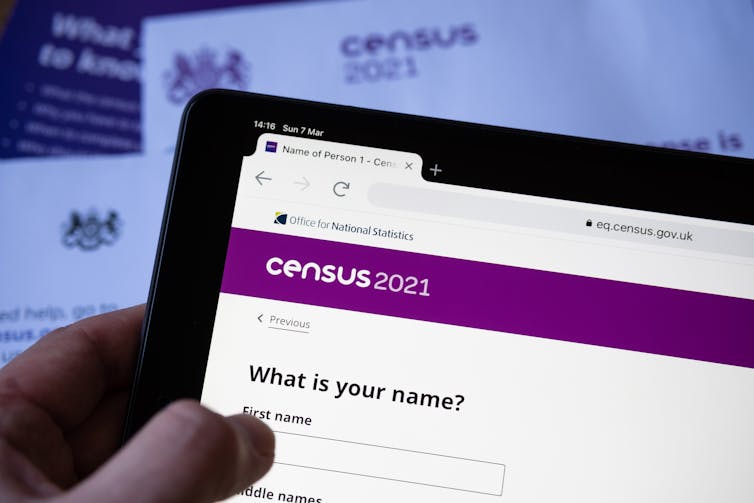Ink Drop/Shutterstock
In England, Wales and Northern Ireland, everyone should have received either a letter with a 16-digit code or a paper form for the 2021 census. There are lots of great reasons why we should respond to the census, aside from it being a legal requirement. Among other things, it’s a good way to help provide an accurate snapshot of your community, which means people will get the services they need at a local level.
The census is a fascinating dataset that’s vital to many areas of research and government decision making. It provides us with a count of the population, but also a wide range of demographic data like age, gender, family relationships, socio-economic information, ethno-cultural background, health, and some voluntary questions, including religious identity and sexuality.
This is the first census that most people will be asked to complete online. However, some have received paper forms through the post, while others have just received a letter asking them to fill in the census online. Though the mechanics of the census may appear complex, the reasons why are actually quite straightforward.
Online or by post?
So who gets a letter, who gets a form and why? The Office for National Statistics (ONS) (which is coordinating the census) has tried to determine who gets what by assessing which households are likely to find it impossible or more difficult to respond to the census online. These households (around 10% of all households) have been sent a paper form. Everyone else has received a letter with a code, asking them to complete the form online (however, it’s important to note that if you received a form, you can still respond online and if you got a letter, you can request a paper form if you want).
There are a number of good reasons for filling out your form online – it saves the ONS time and money when collating the results and means we can get more accurate data.
You might be thinking: “What about my Aunt Muriel who received a letter? She doesn’t use the internet. Why hasn’t she got a form?” This is because the ONS doesn’t know who’s able and willing to submit the form online – they can only model this based on the data they have.

mundissima/Shutterstcok
As statistician George Box said: “All models are wrong, but some are useful.” When we use information about a group of people to make judgements about the individuals in that group, we call this an ecological fallacy. While the ONS has modelled who will (and who will not) respond online, even if this puts 95% of people in the right group, there will be some errors due to cases that contradict the model.
For those who the ONS has deemed unable or unwilling to complete the census form online, there will be some who don’t fit this criteria and vice versa. This is why the ONS has included a code on the forms. If you know someone who needs a form but is having problems requesting one, you can request one on their behalf.
The hard to count index
How did the ONS model this information? The ONS typically creates a “hard to count” index to measure who might not respond to the census (also used for the 2001 and 2011 censuses). However, the 2021 census is different as this is the first time it’s been run “online first”, which means the ONS also had to include the digitally excluded into its index.
Read more:
Census 2021: why it’s important to take part and what happens to your information
The key data used to drive this was internet access data from Ofcom for both fixed lines and mobile internet connectivity, looking at availability, usage and download speeds. This was combined with information on who has already interacted with government websites (such as via the DVLA and HMRC).
This data was used to create an area-based model, with each area assessed as either being able to complete the census online, or needing paper forms. This was tested and refined together with many other aspects of the census in the ONS’s big rehearsal for the census in 2019.
When can I fill it out?
The online census form is quick and easy to fill out. It takes about ten minutes per household plus ten minutes for each person. If you’ve ever renewed your passport or driving license online, you’ll find filling in the census very similar. You can fill out the survey (online or by post) as soon as you receive your code, there’s no need to wait until March 21. If anything does change before then, you can always update your information.
Filling in the census is a legal requirement and you can be fined up to £1,000 if you don’t complete it. This is because the data needs to be as complete as possible for it to be useful.
There are many more details on the ONS website, particularly in their papers documenting the methods used to run the census, the “hard to count” and “maximising response” papers. Whether you opt for an online for or a paper one, make sure you fill in the census. After all, this is our best chance at understanding ourselves as a population.
![]()
Nick Bearman does not work for, consult, own shares in or receive funding from any company or organisation that would benefit from this article, and has disclosed no relevant affiliations beyond their academic appointment.











